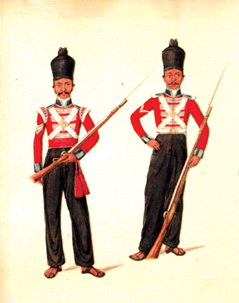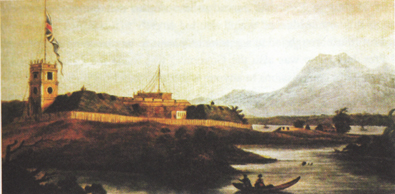Registered with the Registrar of Newspapers for India under R.N.I 53640/91
Vol. XXVIII No. 7, July 16-31, 2018
The Madras sepoy and SE Asia

Madras Sepoys in 19th Century SE Asia
Most Indians would probably be surprised if you were to tell them that long before MacArthur’s marines assault-landed on Philippine’s beaches during the World War II, our Madras sepoys had stormed the Fort of Manila with a British regiment for company and wrenched the city from its Spanish defenders. It is with this unique episode of 1762 that Singapore-born writer and military historian, N. Nedumaran, commences his fascinating narrative of the epic saga of the Indian sepoys, particularly Madras ones, who played a pivotal role in the creation of the Straits Settlements of South-East Asia and early shaping of the region, Madras, in an outstanding book titled The Forgotten Sentinels – The Sepoys of Malaya, Singapore & South-East Asia (The Founding Years: 18th to early 20th Centuries).
After outlining the origins of the sepoy armies in 18th Century India in the opening chapter, the author takes us on a roller-coaster ride of this distinctive breed of soldiers battling along as the sword arm of the English East India Company while it establishes itself in one Strait Settlement after another. These events, which seldom find mention as anything more than mere footnotes in the larger narrative of the sepoys’ engagements in the subcontinent, emerge as luminous and captivating episodes in the lucid and story-like narration.
After the Manila expedition the narrative moves on to the British entry into Dutch-dominated Malay Archipelago, with the establishment of their first fort – and South-East Asia’s first Sepoy Garrison – at Bencoolen, Sumatra. This was a post so remote and inhospitable that it put the sepoys through an acid test of endurance and resolve, as well presented them with the horrendous experience of fighting locals who practise cannibalism. The British quest to establish a strategic base in the Bay of Bengal – with the Straits of Malacca under Dutch control led to the founding of Penang in 1786 by the intrepid merchant mariner, Francis Light, a historic event that would also signify the arrival of the first sepoys to the Malay Peninsula. With no agency to maintain law and order in the newly-found settlement the sepoys took on a police role, in effect installing themselves as the first policemen of the Straits. Soon, after a hiatus of five years, they were back fighting a full-scale war with the forces of the Sultan of Kedah, who had granted the right to found the port to the British but, dissatisfied with the outcome of the agreement, turned hostile. It ended with the gallant feat of some 400 sepoys trouncing a 10,000-strong enemy in a pre-dawn amphibious assault on April 12, 1791. The Sultan was brought to terms and the East India Company’s possession of Penang secured.

Fort Marlborough, Bencoolen, Sumatra.
Barely a decade after the founding of Penang, Malacca itself was turned over to the British by the Dutch for fear of it falling to a resurgent militarist France; and we have the grand spectacle of a mighty armada sailing from Madras with a 2,000-strong British-Indian expeditionary force to the distant waters that, the author recalls, the martial ancestors of the sepoys on board had traversed seven centuries ago with the naval forces of the Chola Kingdom. At the dawn of 19th Century we find sepoys from the Bengal Native Infantry being inducted into the Straits for the first time, the East India Company overcoming the caste prejudice that prevented them from overseas operations by creating marine battalions of volunteers. Over a decade later, in 1811, we have an even mightier armada sailing further for the invasion of Java; this time around with a sepoy force predominantly comprising Bengal army men. In less than a decade thence, we have the momentous event of the founding of Singapore by Sir Thomas Stamford Raffles. The chapter that follows with an imaginative profiling of the anonymous sepoy of the day – Raffles came ashore for negotiations with the local ruler (Temmenggong) accompanied by the ground forces commander, Major William Farquhar, and a single sepoy-escort, who remains unnamed in the records – makes poetic reading.
The meticulous chronicling of the immense contribution of the sepoys in the early growth and development of Singapore and the rest of the Strait Settlements the book does, is far too elaborate a topic to discuss in a review (It varied from fighting all-out wars like the Naning and Perak Wars – often precipitated by East India Company’s belligerent attitude – to putting down gang wars of the Chinese immigrants and policing to maintain law and order). Nevertheless, certain interesting aspects of the involvement of people from the Indian subcontinent, both soldiers and civilians, many who were to become permanent settlers, make interesting reading. One is the lot of convict labour from India who strangely left a hallmark of professionalism building the city of Singapore. Then there are the camp followers who formed the ‘Military Bazar’, the chai, mithai and pan wallahs, the dhobis and the rest, not to mention the dancing girls and prostitutes; all thriving in their trades. On a different social stratum we find the Chettiars, South Indian moneylenders, who gave a jump-start to the early economy of the region when there were hardly any banks around. There were entrepreneurs too, like one Narayana Pillai, a Company clerk who started the first construction company in Singapore, and who was also responsible for building Sri Mariamman Temple, the first Hindu temple in the settlement. The sepoys and the civilians from India also left their imprint on the ethnicity of the population of the region to a certain extent through marriages or cohabitation. The earliest instances of these were of the Madras sepoys of the Manila expedition who supposedly mutinied and stayed behind. An oral tradition in the Philippines tells of their descendants living on the outskirts of Manila.
Post the Sepoy Rebellion, which shook India in 1857 (and kept the authorities in the Straits in a state of high tension for the large number of sepoys in the region), Sikhs and Gurkhas, who were newer entrants into the Bengal Army, began to be inducted into the Straits region. Although they were to come in only by the last quarter of the century they made their presence eminently felt. While the Gurkhas, for whom the Malay expedition was their first overseas assignment, excelled in combat wherever they were engaged keeping with their fierce reputation, the Sikhs were to create their own legacy as policemen as well, forming the first ever paramilitary forces of Malay states. The Malay State Guides raised in 1896, which made invaluable contribution to the maintenance of public order until its disbandment in 1919 (by which time a professional police force had taken shape), was exclusively constituted of Sikhs and Pathans.
In the overall portrayal somehow the comparatively recent history commencing with the founding of Singapore overshadows the incomparable role the Madras sepoys played in the British dominance in the Straits region; just about the only flaw I could discern in the otherwise excellent narrative. Commencing with Manila, most of the fighting in the region was done by these doughty men who were mostly volunteers. Even during the 19th Century, but for the Java expedition by the Bengal sepoys and induction of a marine regiment of theirs, what fighting was there was mostly done by the Madras sepoys (including the first and second Naning Wars and putting down the Chinese gangs) and they continued to man the garrisons right till 1876 when the sepoy garrisons were withdrawn en masse. And the few operations wherein their infantry was not present, their sappers and miners and artillery were invariably there. They left a proud legacy unparalleled by any in the creation of the Strait Settlements as much as they did in triumphing over the whole of peninsular India and in the Burma and China Wars; spectacular feats of arms sadly hidden in the annals of history (Curiously the caption under a painting on the First Anglo-Burma War speaks of the landing of ‘combined forces of Bengal and Madras’ at Rangoon, which can only mean that the originator was misinformed; because the First Burma war was an exclusively Madras Army campaign. So was the First China War except for the presence of one Bengal Army voluntary unit. In fact any meaningful participation of the Bengal Army units in overseas operations began to take place only after 1857 when its troop composition underwent a change.)
Though the rivalry between European powers in the Straits had come to an end after the Anglo-Dutch treaty of 1824 that divided the region between the two, the sepoys’ association with the region was to continue for another half a century. The British continued to maintain the sepoy garrisons in strength as the bulwark of their authority in their settlements. At one stage these settlements were even collectively elevated to the status of a fourth Presidency – after Madras, Bengal and Bombay – headquartered at Penang. Penang would be eventually stripped of its significance with the rapid growth of Singapore as the principal commercial and strategic hub of the region – and a prominent global one as well in future – that would also become the capital of the Strait Settlements. The year 1876 saw the end of more-than-a-century old deployment of sepoys in the Straits when all their units were shipped home, being replaced by British troops. Apparently, the British Empire needed these hardcore fighters for their newer wars elsewhere like the Afghan and Burma Wars, towards the end of the century. Malaya and Singapore would of course echo to the sepoy boots once again during World War II, when the Indian Army would form the prime force fighting the Japanese.
The exhaustive narrative also covers the Opium Wars with China and the Boxer Rebellion there, although the settlers of the Straits were only bystanders watching in awe as the mighty armadas stopped over for replenishment at Singapore harbour and passed on. Even the events of the Indian subcontinent like the Barrackpore Mutiny of 1824 and the Sepoy Rebellion of 1857 are given fairly extensive coverage for their relevance to the happenings in British Malaya.
The author has also made a remarkable attempt to analyse the psyche of the sepoys – a complex issue that has baffled the students of history world over. What made these men fight so loyally for an alien power for two centuries through some of the bloodiest battlefields in the world? The military esprit de corps involved is beyond the scope of this review to discuss.
A gifted sketch artist, the author has illustrated the book with plenty of sketches and paintings. That he has been able to create such a work almost exclusively based on European records is in itself a monumental achievement; the only exception being Munshi Abdullah whom he calls a ‘A Child of the Sepoy Era’, a Malacca boy who became Raffles’ Malay language tutor and the only Asian to have left any eye-witness accounts of the times. The sepoys either couldn’t or didn’t write their story. The book is a marvellous effort that depicts the story of these magnificent fighting men who wrote the history of most of Asia with their sweat and blood but have faded from our collective memory.
Copies of the book can be ordered within India from:
Mr. D. Nedunchezhiyan
Ph: 9840072090
Email:
chez@indiacollegefinder.org
byCapt. D.P. Ramachandran

